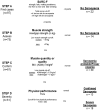Prognostic Features of Sarcopenia in Older Hospitalized Patients: A 6-Month Follow-Up Study
- PMID: 38892826
- PMCID: PMC11172762
- DOI: 10.3390/jcm13113116
Prognostic Features of Sarcopenia in Older Hospitalized Patients: A 6-Month Follow-Up Study
Abstract
Background: Sarcopenia is associated with adverse health outcomes. Understanding the association between sarcopenia, multidimensional frailty, and prognosis is essential for improving patient care. The aim of this study was to assess the prevalence and prognostic signature of sarcopenia in an acute hospital setting co-led by internists and geriatricians. Methods: Sarcopenia was assessed by applying the European Working Group on Sarcopenia in Older People (EWGSOP2) algorithm, including the SARC-F score, handgrip strength, bioelectrical impedance analysis (BIA), and Timed Up and Go (TUG) test, to 97 older multimorbid inpatients (76.5 ± 6.8 years, 55% women). The patients underwent a Comprehensive Geriatric Assessment (CGA) including an evaluation of Geriatric Syndromes (GSs) and Resources (GR) and prognosis calculation using the CGA-based Multidimensional Prognostic Index (MPI), European Quality of life-5 Dimensions (EQ-5D-5L) scale, Rosenberg Self-Esteem Scale (RSES), and Geriatric Depression Scale (GDS). Information on survival and rehospitalizations was collected 1, 3, and 6 months after discharge. Results: Sarcopenia was present in 63% (95% CI: 54-72%) of patients and categorized as probable (31%), confirmed (13%), and severe sarcopenia (18%). Sarcopenic patients showed significantly higher median MPI-values (p < 0.001), more GSs (p = 0.033), fewer GR (p = 0.003), lower EQ-5D-5L scores (p < 0.001), and lower RSES scores (p = 0.025) than non-sarcopenic patients. Six months after discharge, being sarcopenic at baseline was predictive of falls (p = 0.027) and quality of life (p = 0.043), independent of age, gender, and MPI. Conclusions: Sarcopenia is highly prevalent in older hospitalized multimorbid patients and is associated with poorer prognosis, mood, and quality of life up to 6 months after discharge, independent of age, sex, and MPI as surrogate markers of biological age.
Keywords: EWGSOP2; MPI; comprehensive geriatric assessment; frailty; older people; prognosis; sarcopenia.
Conflict of interest statement
The authors declare no conflicts of interest. The funders had no role in the design of the study; in the collection, analyses, or interpretation of data; in the writing of the manuscript; or in the decision to publish the results.
Figures



Similar articles
-
Profiles of Geriatric Syndromes and Resources in Older Patients with Atrial Fibrillation.J Clin Med. 2024 Jul 9;13(14):4009. doi: 10.3390/jcm13144009. J Clin Med. 2024. PMID: 39064049 Free PMC article.
-
The prognostic fingerprint of quality of life in older inpatients : Relationship to geriatric syndromes' and resources' profile.Z Gerontol Geriatr. 2022 Feb;55(1):38-43. doi: 10.1007/s00391-021-01978-5. Epub 2021 Oct 6. Z Gerontol Geriatr. 2022. PMID: 34617144 English.
-
The impact of oral health on prognosis of older multimorbid inpatients: the 6-month follow up MPI oral health study (MPIOH).Eur Geriatr Med. 2021 Apr;12(2):263-273. doi: 10.1007/s41999-020-00427-7. Epub 2020 Nov 18. Eur Geriatr Med. 2021. PMID: 33206351
-
SARC-F Is Inaccurate to Identify Geriatric Rehabilitation Inpatients at Risk for Sarcopenia: RESORT.Gerontology. 2022;68(3):252-260. doi: 10.1159/000516117. Epub 2021 Jun 1. Gerontology. 2022. PMID: 34062544
-
Screening, Diagnosis and Management of Sarcopenia and Frailty in Hospitalized Older Adults: Recommendations from the Australian and New Zealand Society for Sarcopenia and Frailty Research (ANZSSFR) Expert Working Group.J Nutr Health Aging. 2022;26(6):637-651. doi: 10.1007/s12603-022-1801-0. J Nutr Health Aging. 2022. PMID: 35718874 Review.
Cited by
-
Health outcomes of sarcopenia: a consensus report by the outcome working group of the Global Leadership Initiative in Sarcopenia (GLIS).Aging Clin Exp Res. 2025 Mar 22;37(1):100. doi: 10.1007/s40520-025-02995-9. Aging Clin Exp Res. 2025. PMID: 40120052 Free PMC article. Review.
-
The Importance of Multidimensional Frailty in Clinical Practice.J Clin Med. 2024 Dec 16;13(24):7645. doi: 10.3390/jcm13247645. J Clin Med. 2024. PMID: 39768568 Free PMC article.
References
-
- WHO . World Report on Ageing and Health. WHO; Geneva, Switzerland: 2015.
-
- Bianchi L., Ferrucci L., Cherubini A., Maggio M., Bandinelli S., Savino E., Brombo G., Zuliani G., Guralnik J.M., Landi F., et al. The Predictive Value of the EWGSOP Definition of Sarcopenia: Results from the InCHIANTI Study. J. Gerontol. Ser. A. 2015;71:259–264. doi: 10.1093/gerona/glv129. - DOI - PMC - PubMed
-
- Yeung S.S.Y., Reijnierse E.M., Pham V.K., Trappenburg M.C., Lim W.K., Meskers C.G.M., Maier A.B. Sarcopenia and its association with falls and fractures in older adults: A systematic review and meta-analysis. J. Cachexia Sarcopenia Muscle. 2019;10:485–500. doi: 10.1002/jcsm.12411. - DOI - PMC - PubMed
Grants and funding
LinkOut - more resources
Full Text Sources
Research Materials
Miscellaneous

